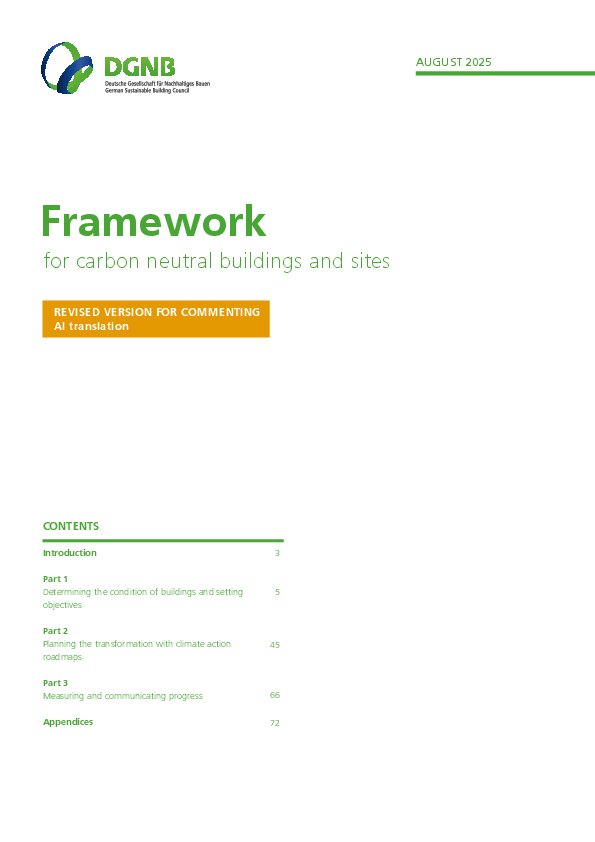Revision of the DGNB Framework for Carbon Neutral Buildings and Sites
The DGNB has updated its framework for carbon neutral buildings and sites. The revised version (as of August 2025) was available for public comment until 30 September 2025. Comments were requested on the general practical applicability and, in particular, on the requirements formulated in the (new) climate action categories. Assessments of the newly introduced energy targets were also welcome.
Note: The commenting phase has been closed. Based on the comments received, the revised version will be finalised by spring 2026. Below is an overview of the most important changes.
The most important points of the revised version at a glance
This version is an update and further development of the 2020 edition.
Objectives of the revision
With the revised version, the DGNB aims to...
- provide stakeholders with even more structure and reliability for necessary decisions on the path to carbon neutrality through precisely defined and clearly formulated (milestone) objectives.
- include aspects concerning the role of buildings as an active part of the energy transition.
- incorporate new regulatory frameworks and the resulting requirements for market participants.
- integrate new reporting requirements for companies.
- implement feedback from users in the field to optimise applicability.
Key aspects of the revision
In addition to refinements and optimisations for better applicability, the revisions particularly affect the following aspects.
On the path to a carbon neutral building stock, it is important to make the right investments in our building stock and the necessary new construction from the perspective of climate goals, thereby facilitating the implementation of the most effective and efficient steps. In order to provide guidance to building owners, investors and political decision-makers, the framework offers an unambiguous framework for action. The revised version has been reduced to the essential elements and now comprises only three parts instead of four. In particular, references to the DGNB System have been omitted, as the criteria sets for the various system variants are regularly updated and the ambitions are adjusted accordingly in line with the objectives already achieved.
- Part 1: Determining the condition of the building and setting objectives
- Part 2: Planning the transformation with climate action roadmaps
- Part 3: Recording and communicating progress
In order to focus not only on the long-term objective of climate neutrality, but also to take a closer look at the milestones and ambition levels along the way, the DGNB defines three climate action categories in its framework. These categories help to ensure the timely implementation of announced commitments and to effectively align building stocks with Europe's climate and energy goals. The objective is to provide a reliable basis and achievable, meaningful interim targets for the necessary investments, capacity and competence building, and the necessary realignment of established business models and processes.
- Category 1: Carbonneutral buildings
- Category 2: Buildings prepared for climate neutrality
- Category 3: Buildings with a climate action roadmap
The three categories are explained in Part 1 (Sections 1.2 to 1.4) of the revised version of the DGNB Framework for carbon neutral buildings and sites.
In the revised version of the DGNB Framework for carbon neutral buildings and sites, energy objectives will be formulated in the three climate action categories in addition to CO2-objectives. These objectives will take into account overall energy efficiency (for operation and use), renewable energy supply and the contribution to the energy transition.
Information on the defined objectives can be found in Part 1 (Sections 1.3 and 1.4) of the revised version of the DGNB Framework for carbon neutral buildings and sites.
To set annual target values and cumulative CO2-limits, the new version of the DGNB Framework specifies the use of national climate and energy target paths (reduction paths) as a basis. The revised version publishes specific CO2-limits and CO2-target values applicable in Germany for three types of building use. These can be used by users of the DGNB Framework for carbon neutral buildings and sites to check whether the performance of buildings or measures or climate action roadmaps are compliant with national climate and energy targets.
Information on this can be found in section 2.3 in particular.
The definitions set out in the DGNB Framework can be used to determine, evaluate, compare and optimise all significant final energy consumption and greenhouse gas emissions from the operation and use of both new and existing buildings and entire portfolios.
A new feature achieved is that a concise scope can also be applied to facilitate an easier introduction to the topic:
- Scope 'Total energy use (use and operation)'
- Reduced scope 'Energy use in operation (excluding energy consumption related to use and users)'
The reduced scope of consideration 'operation' covers the 'regulated' scope defined by the European Energy Performance of Buildings Directive (EPBD) and national implementation rules, and thus the 'services related to the energy performance of buildings' (or 'EPB services'). The scope of consideration to which a project-specific classification according to the defined categories refers must always be specified.
Details on the scope of consideration can be found in Part 1 (Section 1.4).
Frequently asked questions
Yes.
The DGNB has revised its certification system for buildings in use in collaboration with European partners. The criteria, with their adapted requirements, were open for public comment until 13 June 2025. Like the current version, the new version refers to the DGNB Framework for carbon neutral buildings and sites. As the market version of the DGNB System for Buildings In Use will be published before the revised version of the DGNB Framework, a transition phase will apply. Its aim is to ensure a simple and fair transition for all users. More detailed information will be provided once the new version of the DGNB System for Buildings In Use is released.

